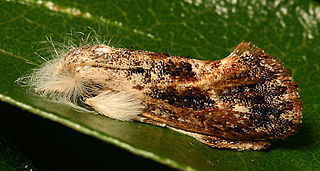
Acrolophinae is a family of moths in the order Lepidoptera. The subfamily comprises the burrowing webworm moths and tube moths and holds about 300 species in five genera, which occur in the wild only in the New World. It is closely related to the Tineidae family.

Eurema is a widespread genus of grass yellow butterflies in the family Pieridae.

Syllepis is a genus of moths of the family Crambidae described by Felipe Poey in 1832.

Litoprosopus is a genus of moths in the subfamily Dyopsinae of the family Erebidae.
Mastigophorus is a genus of moths of the family Noctuidae described by Poey in 1832.
Eupyrrhoglossum is a genus of moths in the family Sphingidae first described by Augustus Radcliffe Grote in 1865.

Amphonyx is a genus of hawkmoths in the family Sphingidae erected by Felipe Poey in 1832.

Eurema dina, the dina yellow, is a butterfly in the family Pieridae. The species was first described by Felipe Poey in 1832. It is found from Panama north to southern Florida. The species is regularly recorded from southern Texas and south-eastern Arizona. The habitat consists of forest edges, brushy fields and open forest.

Acrolophus plumifrontella, the eastern grass-tubeworm moth, is a moth of the family Acrolophidae. It is found in North America, including Alabama, Arizona, Arkansas, Florida, Georgia, Illinois, Indiana, Iowa, Kansas, Kentucky, Louisiana, Maryland, Mississippi, Missouri, New Jersey, New York, North Carolina, Ohio, Pennsylvania, South Carolina, Tennessee, Texas and Virginia.

Acrolophus popeanella is a moth of the family Acrolophidae. It is found in the eastern United States, from New Jersey and Ohio south to Florida and west to Illinois, Nebraska and Texas.

Acrolophus arcanella is a moth of the family Acrolophidae. It is found in eastern North America.

Acrolophus texanella is a moth of the family Acrolophidae. It is found from Maryland to Florida and to Texas.

Acrolophus mycetophagus, commonly known as the frilly grass tubeworm moth, is a moth of the family Acrolophidae. It was described by Davis in 1990. It is found in the southern United States from Virginia and Florida to Texas.

Acrolophus panamae, the Panama grass tubeworm moth, is a moth of the family Acrolophidae. It was described by August Busck in 1914. It is found in North America, including Alabama, Delaware, Florida, Georgia, Maryland, Mississippi, New Jersey, North Carolina, South Carolina and Virginia.
Acrolophus propinqua is a moth of the family Acrolophidae. It is found in North America, including Alabama, Florida, Georgia, Illinois, Louisiana, Maryland, Mississippi, North Carolina, New York, Ohio, South Carolina, Tennessee, Virginia and West Virginia.

Acrolophus cressoni is a moth of the family Acrolophidae. It is found in North America, including Alabama, Arizona, Arkansas, Florida, Georgia, Kentucky, Louisiana, Mississippi, New Mexico, North Carolina, Oklahoma, Tennessee and Texas.
Acrolophus piger, the piger grass tubeworm moth, is a moth of the family Acrolophidae. It was described by Harrison Gray Dyar Jr. in 1900. It is found in North America, including Alabama, Florida, Mississippi, North Carolina, South Carolina and Texas.
Eucereon guacolda is a moth of the subfamily Arctiinae. It was described by Poey in 1832. It is found on Cuba.













